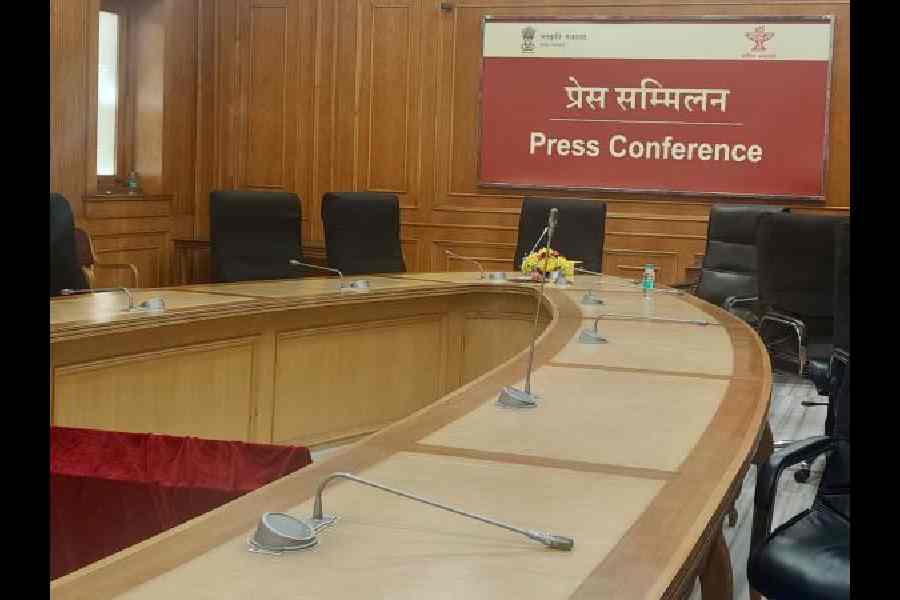 |
Bhubaneswar, Feb. 13: Local initiatives coupled with religious beliefs can work wonders to promote tourism and conserve wildlife and their habitats. People of Huma and Maneshwar near Sambalpur town have not only proved this right, but put the two places on the tourism map of the country.
While the residents (mainly the fishing community) of Huma near the leaning temple of Lord Bimaleswar have conserved the Mahashir fish (Tormosal mahanadicus), locally known as Kado, people living near the three-century-old Maneshwar temple have protected the Indian soft shelled turtle (Asperadetus gangeticus) in the temple pond. While Huma is about 27km from Sambalpur town, Maneshwar is just four km away from the historic city known for river Mahanadi, goddess Samaleswari and the famous Sambalpuri saris.
Huma
Huma is the only leaning temple in India and for that matter, in the entire world. Perhaps after the leaning tower of Pisa in Italy, it would be the second such structure situated on the beautiful river basin of Mahanadi and the picturesque locality attracts thousands of visitors everyday. However, the Kado or Mahashir fish do attract much of the attention of the tourists, who can even feed them near the river or while taking boat ride in it.
Divisional forest officer (DFO) Sambalpur (south) Santosh Banchur said the temple in Huma is a prime attraction for tourists and the leaning structure could be due to the movement of the rocky plates underneath the structure. “The entire area is made of hard rocks, but as there is the huge Mahanadi river basin, the difference in geological plates might have moved the structure creating the wonderful effect. But the other interesting part is the fish, which are seen in large numbers in the area. This fish is originally seen in the Gangetic zone, but this sub-species is endemic to river Mahanadi and in the Huma region only. So biologically, the presence of this fish species is a significant part of the entire river eco-system,” he added.
Local residents, especially the fishing community, have adopted special measures and they never catch these fish from the river. Rather, they make people aware of the role of fish in the river eco-system. While the temple of Lord Bimaleswar (Shiva) and his abode is a unique form of architecture due to its slanting structure, legend has it that the fish in the river are an incarnation of Vishnu. This is believed to be his “matsya” avatar.
DFO Banchur also added that the state government has submitted a proposal to the Centre regarding the creation of a wildlife conservation zone near the Huma site to protect these fish.
According to local folklore, a fisherman and his wife turned into stone while cutting Kado fish. There is a monument on an island opposite the temple, where statues of this fisherman and his wife are present. The local fishermen said that that they generally avoid catching these fish. If they do get any Kado, they release them. Catching or hurting these fish is considered a sin.
Since Huma temple is a monument of archaeological importance, the department of tourism and state archaeology are also taking steps to conserve it. Considering that the high concentration of fish is one of the major attractions of the area, , the department is interested in retaining this traditional practice. The devotees feed “bhog” (temple offerings) to these fish, which is considered a holy act. The best season for sighting Kodo fish is from winter, (after Kartik Poornima) to the beginning of the rains. During this time, the water is clear and slow in its flow.
Apart from the Mahashir, the area is also a suitable habitat for wild animals also like jungle cats, small clawed otters, jackals and various water birds. The local people, especially fishermen, are closely associated with the otter, since the animal helps help them to catch fish. Therefore it is important to keep a track of the status of otters in this area.
Ecologist Prasad Dash of social service organisation Vasundhara said the people's initiative could be considered a community's conservation initiative (CCI), which means any initiative taken by the local people towards protection and conservation of a forest and wetland to wild varieties of plants and animals through their own beliefs and traditions which could be one of the tools to enhance sustainable livelihood to thousands of dependent community members with due recognition from the government.
Huma and Maneshwar are two such examples near Sambalpur town where people have protected and conserved a freshwater turtle and a freshwater fish based on their religious believes. But through these initiatives, the greatest beneficiary is the tourism sector as the protection measures have added more value to their already existing tourism potential.
Maneshwar
In Maneshwar, the local people have conserved the Indian soft-shelled turtle (Asperadetus gangeticus), which is also known as the vulture of the water in the huge temple pond. The soft-shelled turtle is now facing an extinction threat due to over-hunting for meat and habitat destruction owing to various anthropogenic activities in different part of the country.
Maneshwar is situated about 4km from Sambalpur town on the way to Bhubaneswar. The place got its name from the three-century-old Maneshwar temple of Lord Shiva, an important Hindu shrine in the area. However, the freshwater turtles present in the temple water tank is a unique feature and they attract a lot of tourists.
The temple water tank, which is situated over an area of about three hectare, houses about 1,200 adult turtles. This water tank is attached with the small river, Malati-jhor, through a water channel. A canal adjacent to tank is attached to River Mahanadi. This network also allows the movement of turtles outside the tank during the rainy season when the water level is high. Thus, we can say that the gene pool of the turtles is not only confined to tank and there is gene flow of species ensuring the endurance of the species.
Dash said: “Whoever catches a turtle in nearby area (generally in rainy season turtles disperse in nearby agricultural fields), releases them in the temple pond. The tank is surrounded by the temple on one side and an earthen embankment on three sides with stone embankments at two places for people to get into the tank. There are some submerged rocks inside the tank especially used by the turtles for sun-bathing. During winter, the water level goes down and exposes the surrounding surface and hundreds of basking turtles can be seen in groups. Hence the tank is proving to be a holistic system holding a stock of endangered species.”
Local residents say that the present turtle population could be the descendants of a few turtles released by the king who built the temple.
“From ecological perspective, the freshwater turtles are very important due to the vast array of their diet. As they are carnivorous, they usually feed on rotting flesh but are known eat more or less everything. They help in reducing organic matter in the water body, which otherwise create a conducive environment for other annoying pests and affect the water quality” said biologist Pratyush Mohapatra.
Mohapatra added that the turtles also helped to control water weeds, such as the water hyacinth and control pests like mosquitoes and keep the whole water body clean. Thus there is a symbiotic relation between turtles and humans, where turtles get protection and in turn keeps the water clean. “The Indian soft-shelled turtles or the Ganges soft-shelled turtle is distributed in large river systems like Mahanadi, Ganges and Indus. These also occur in large ponds and water bodies in the mainland. Besides Maneshwar, these turtles are also get protection in places like Narendra Pond in Puri, Champeshwar in Cuttack and Golia in Ganjam district. They are also protected in the temples outside the Orissa like Kamakhya Temple at Guwahati and Gangetic softshell turtles in the Tripureshwari temple at Udaipur, Tripura and Shiva temple at Tinisukia, where they are naturally distributed,” he added.
Threats
The major threat identified by temple committee, however, is siltation of the water tank. The structure is facing a natural aging process through accumulation of silt and debris, due to which its water-holding capacity is reducing. The temple committee is proposing a renovation of the tank to remove the accumulated debris and silt. However, the renovation work is pending as the committee is concerned about the turtles, as cleaning and excavation operation might cause harm to the animals and their breeding grounds. Therefore they are planning a phase-wise renovation work with the minimal possible harm to the turtles.
Local people, especially fishermen, think that the population of Kado fish is declining near Huma. Therefore the question naturally arises that how is the population declining despite these protection efforts? According to local residents, the main reason for fish population decline is over fishing in upstream and downstream areas. In Huma, there should a demarcation zone, think many people.
In practice, biodiversity is protected and conserved through the creation of a protected areas as a part of officially established networks throughout the country but the examples shown by the people of Huma and Maneshwar are some where communities are conserving wildlife and its habitat as a part of their religious beliefs. In fact, the philosophy of conservation lies in the ethos and culture of society that strengthen human-nature relationship.











